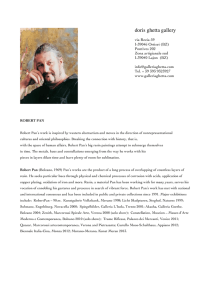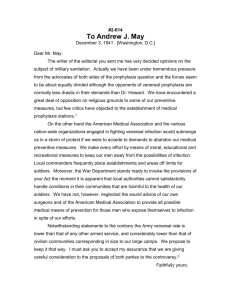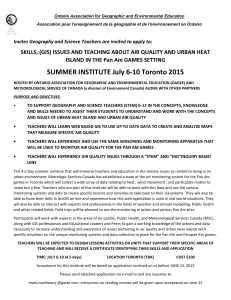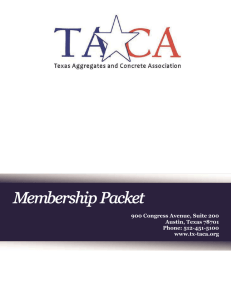2-384 - George C. Marshall Foundation
advertisement
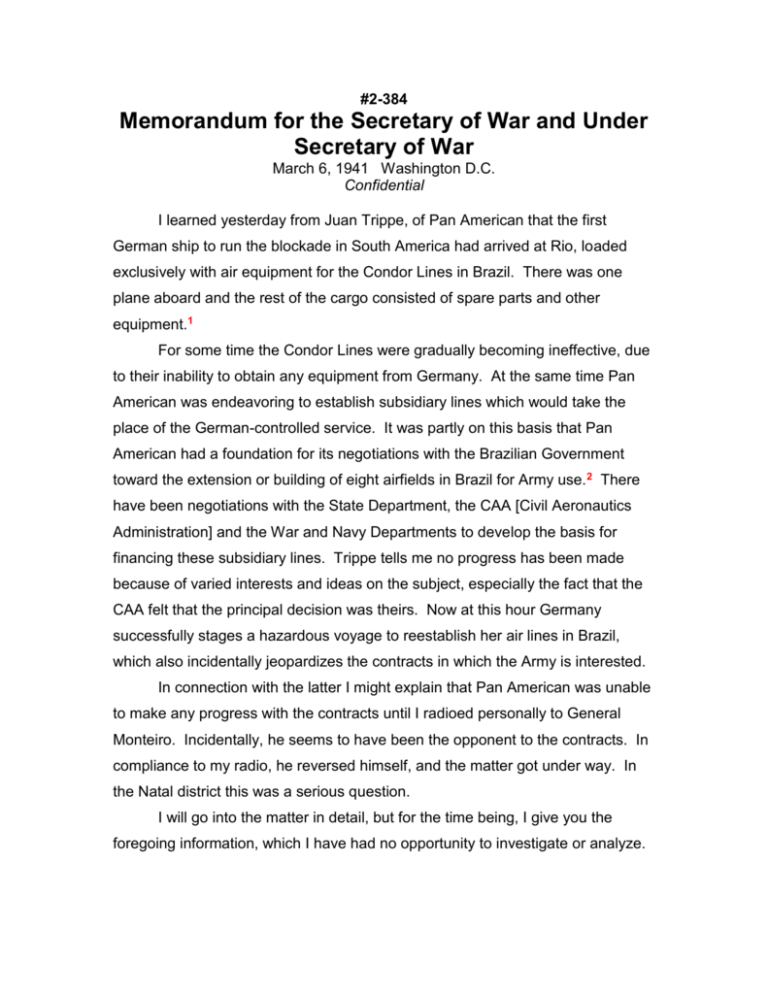
#2-384 Memorandum for the Secretary of War and Under Secretary of War March 6, 1941 Washington D.C. Confidential I learned yesterday from Juan Trippe, of Pan American that the first German ship to run the blockade in South America had arrived at Rio, loaded exclusively with air equipment for the Condor Lines in Brazil. There was one plane aboard and the rest of the cargo consisted of spare parts and other equipment.1 For some time the Condor Lines were gradually becoming ineffective, due to their inability to obtain any equipment from Germany. At the same time Pan American was endeavoring to establish subsidiary lines which would take the place of the German-controlled service. It was partly on this basis that Pan American had a foundation for its negotiations with the Brazilian Government toward the extension or building of eight airfields in Brazil for Army use. 2 There have been negotiations with the State Department, the CAA [Civil Aeronautics Administration] and the War and Navy Departments to develop the basis for financing these subsidiary lines. Trippe tells me no progress has been made because of varied interests and ideas on the subject, especially the fact that the CAA felt that the principal decision was theirs. Now at this hour Germany successfully stages a hazardous voyage to reestablish her air lines in Brazil, which also incidentally jeopardizes the contracts in which the Army is interested. In connection with the latter I might explain that Pan American was unable to make any progress with the contracts until I radioed personally to General Monteiro. Incidentally, he seems to have been the opponent to the contracts. In compliance to my radio, he reversed himself, and the matter got under way. In the Natal district this was a serious question. I will go into the matter in detail, but for the time being, I give you the foregoing information, which I have had no opportunity to investigate or analyze. There is still another phase of this Pan American business which Trippe brought to my attention last night, and which I have had no opportunity to investigate. He tells me that as a development of the American Export Line’s effort to parallel Pan American on the Atlantic Flight and in the Caribbean district (the TACA Lines)—there may be a public statement by Thurman Arnold against Pan American—this within a week. The House Committee definitely turned down the American Export Lines as being highly inexpeditious at this time for the Government to be involved in subsidiaries to competing lines—there is not enough business for both.3 The point to this matter is, a public statement at this time would do even more harm to our position in Brazil. Whatever the Department of Justice does in the way of investigation, I think it highly inadvisable at this time for a public official pronouncement to be made against Pan American. It is too important a factor in our hemisphere defense set-up to be publicly discredited—in advance of an investigation. While I have opposed giving them the right of way on new planes at this time, I have quite a contrary view on this new phase.4 G. C. Marshall Document Copy Text Source: Records of the Office of the Secretary of War (RG 107), Secretary of War Safe, Pan American Airways, National Archives and Records Administration, College Park, Maryland. Document Format: Typed memorandum signed. 1. By early 1941 Axis-controlled aviation based in Brazil had expanded operations southward and westward to the Pacific Ocean. Germany’s Condor line, an old, wellestablished firm, serviced Brazil and the southern half of the continent. The Italian LATI line provided transatlantic service from Europe to Natal and Rio de Janeiro. LATI and Air France, a Vichy firm, controlled airfield facilities from Natal southward along the Brazilian coast. The War Department believed that these Axis airlines directly threatened United States war plans for Natal and British shipping in the South Atlantic. (Conn and Fairchild, Framework of Hemisphere Defense, p. 247.) 2. On the Brazilian airfields, see Marshall to Van Voorhis, January 24, 1941, Papers of George Catlett Marshall, #2-351 [2: 396–98], and Conn and Fairchild, Framework of Hemisphere Defense, p. 254. 3. Lieutenant General Van Voorhis strongly supported the entry of “pro-American,” British-owned TACA airlines into the Panama Canal Zone in competition with other carriers. In October 1940 the American Export Airlines contracted to purchase TACA to connect the continental United States to a unified Caribbean network in competition with Pan American. At first, the War Department approved American Export’s bid to take over TACA because it would lead to healthy competition in the Caribbean. (Ibid., pp. 254–56.) In March 1941, however, the War Department enunciated a new Latin American air policy. It supported only Pan American operations south of Mexico City “until Axiscontrolled lines had been eliminated in South America.” The military services then refused TACA’s entry into the Canal Zone. On December 4, 1941, the Civil Aeronautics Board disapproved American Export’s application to acquire TACA; Pan American Airways soon secured dominance over the Latin American skies. (Ibid., pp. 246–47.) Thurman W. Arnold was the assistant attorney general of the Justice Department’s Antitrust Division. 4. Stimson noted on his copy of the memorandum: “Atty Genl will take care of this HLS.” Ward noted on the chief of staff’s copy: “SW saw ATG [Attorney General] at Cabinet meeting and Arnold will make no statement”. Recommended Citation: The Papers of George Catlett Marshall, ed. Larry I. Bland, Sharon Ritenour Stevens, and Clarence E. Wunderlin, Jr. (Lexington, Va.: The George C. Marshall Foundation, 1981– ). Electronic version based on The Papers of George Catlett Marshall, vol. 2, “We Cannot Delay,” July 1, 1939-December 6, 1941 (Baltimore and London: The Johns Hopkins University Press, 1986), pp. 438–439,


